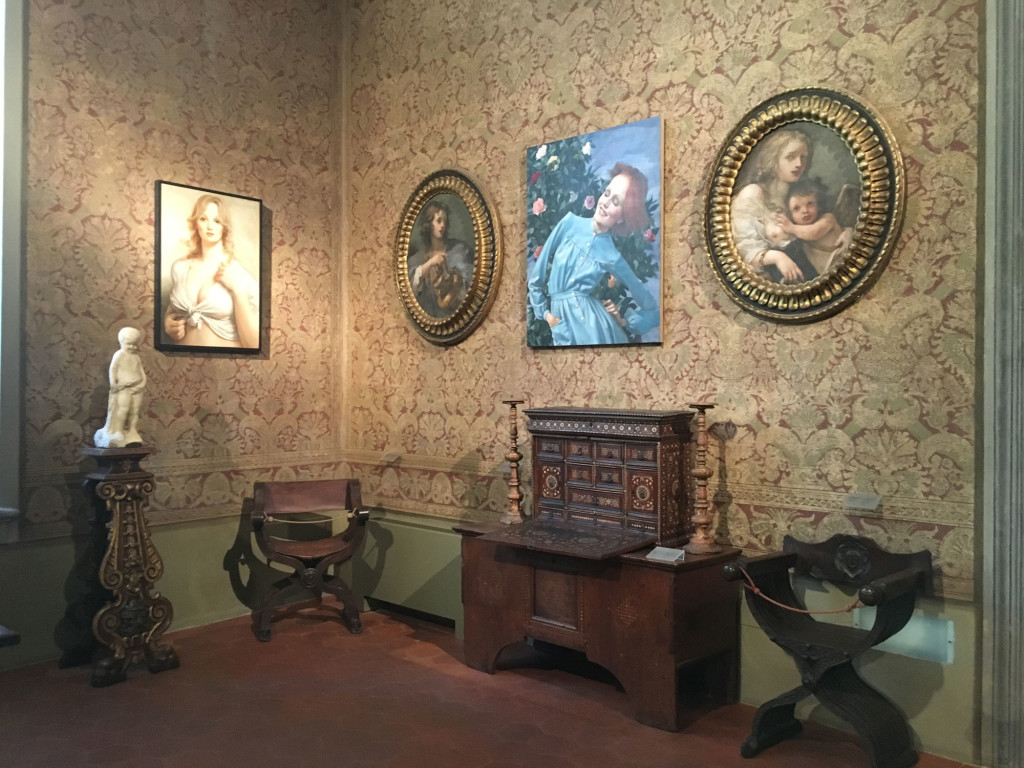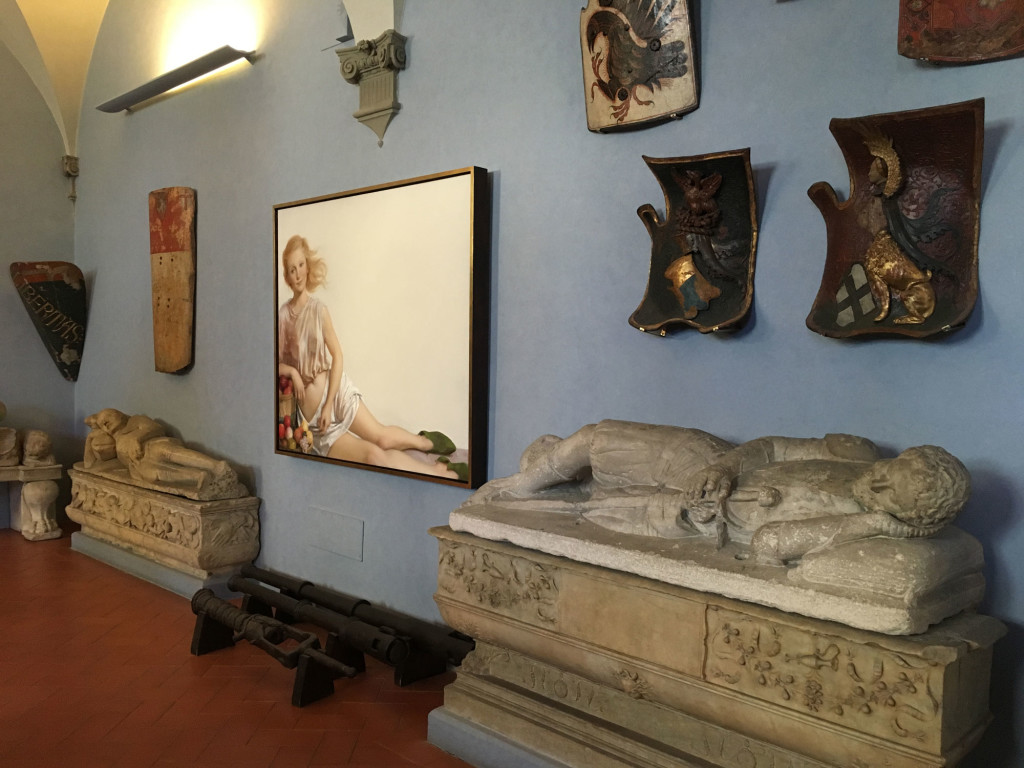

Di Tania Mio Bertolo ed Elena Zinanni (Università degli Studi di Firenze)
Il Museo Bardini di Firenze, sito nello stesso palazzo che a partire dagli ultimi decenni dell’Ottocento fu sede dell’atelier dell’antiquario Stefano Bardini, ospita in questi giorni la mostra personale di John Currin. Per la sua prima esposizione in uno spazio pubblico italiano, l’artista ed i curatori della mostra hanno scelto un allestimento curioso ed originale: il percorso della mostra si sviluppa all’interno del percorso museale. Non c’è alcuna separazione tra la collezione permanente e quella temporanea, anzi esse condividono gli ambienti, le pareti, le teche.
Questo allestimento stimola e coinvolge attivamente il fruitore che, aiutato da una brochure con piantina fornitagli all’ingresso, è difatti chiamato a partecipare quasi ad una caccia al tesoro, a trovare i dipinti profani di Currin tra le pitture sacre del passato artistico italiano, le donne odierne dell’artista statunitense tra le Madonne medievali e rinascimentali della collezione Bardini. Tale fusione degli spazi espositivi genera spontaneamente un confronto tra le opere, che a volte dialogano tra loro ed altre invece contrastano.
Il talentuoso artista americano, che vive ed opera prevalentemente a New York, attraverso i temi e le tecniche pittoriche che sceglie non smentisce di essere figlio della nostra epoca. E tuttavia non è possibile non accorgersi di quanto la sua produzione artistica sia intrisa della pittura rinascimentale e manierista, in un continuo rimando tra passato e moderno: aspetto del suo modus operandi che il Museo Bardini, inteso sia come “contenitore” sia come collezione permanente di dipinti, sculture, tappeti, medaglie e cassoni, concorre a mettere in luce.
Si pensi ad esempio a “Rachel in Fur”, opera del 2002: essa è collocata nella Sala delle Cornici, esattamente di fianco ad una scultura di origine umbra scolpita su legno policromo. A primo impatto l’accostamento della “Madonna in trono con il Figlio” di epoca tardo medievale, con il ritratto della moglie dell’artista in pelliccia e con gli occhiali da sole, opera che ha perlopiù ispirato le campagne fotografiche di alcuni noti marchi della moda internazionale, sembra poco bilanciato, quasi stridente. Tuttavia uno sguardo più insistente non manca di notare la profusione di oro e toni caldi che accomuna le due opere, nonché il sotteso leitmotiv psicologico che lega le due donne rappresentate: entrambe portavoci al femminile delle epoche dalle quali provengono.
E si pensi ancora a “Bent Lady”, ritratto del 2003 esposto esattamente nel mezzo tra la “Venere e Cupido” ed “Ila con il vaso d’oro”, opere del Volterrano: il contrasto evidente tra il formato rettangolare del dipinto di Currin e quello tondo degli esemplari di Baldassarre Franceschini è smussato dalla complementarietà dei cromatismi, dell’ariosità delle chiome e del rossore con il quale entrambi gli artisti tingono le gote e le labbra delle figure ritratte. E ancora si noti come la posizione della donna ritratta nel dipinto “Flora” rimandi sia alle figure scolpite sui sarcofagi appartenenti alla collezione permanente del museo, sia alle Veneri tizianesche.
Merita infine menzione “The Penitent”, opera del 2004 manifesto della mostra. Collocata nella Sala delle Madonne, l’opera si configura come unica dipinta su tela tra quelle esposte nella parete, tutte Madonne col bambino appartenenti alla collezione permanente. Senza lasciarci ingannare dalla vivace cromia adoperata dall’artista americano, o dalla posa disinvolta assunta dalla donna ritratta, l’opera ancora una volta si configura come felice connubio tra moderno e antico. È necessario porre l’accento sul braccio destro della figura femminile, quello mollemente adagiato: esso è così evidentemente sproporzionato che non può non ricordare, al visitatore più attento, il braccio troppo lungo della Vergine dell’Annunciazione leonardesca conservata agli Uffizi. Dunque il rimando al “contenitore” si dilata, supera le mura del Museo Bardini per estendersi alla città di Firenze, culla del Rinascimento, incubatrice di quei modelli artistici che sono per l’artista John Currin esempi con i quali confrontarsi costantemente.
In definitiva, si tratta di una mostra e di un allestimento stimolanti, nei quali il visitatore è positivamente invitato ad interagire attivamente. Va però detto che il percorso espositivo non è correlato né da pennelli esplicativi né da targhette informative: le uniche informazioni fornite al fruitore sono le didascalie riportate nei flayer consegnati all’ingresso. A chi voglia sapere qualcosa in più su John Currin o sul suo percorso artistico non rimane altro, aihmè, che acquistare il catalogo della mostra o effettuare una ricerca personale, fuori dalle mura del museo.
Traduzione di Rachyl Grussing (Istituto Lorenzo de’ Medici)
The Bardini Museum in Florence, situated in the same palace since the late 1800s, was the home of the salon of the antiquarian Stefano Bardini. In this, it hosts today the personal exhibit of John Currin. Exhibited for the first time in a public Italian space, the artist and the curator have chosen a curious and original show: the route of the show is developed inside the museum. There is not any separation between the permanent collection and the temporary, in fact, they share the environment, the walls, the display cases.
This setup stimulates and actively involves the viewer, aided by a brochure with a map provided at the entrance, is in fact almost called to participate in a treasure hunt to find the profane paintings of Currin among the sacred paintings of the past Italian artists, the women of todays’ american artist between the medieval and Renaissance Madonna’s of the Bardini’s collection. Such a fusion of the general exhibition space generates a spontaneous conversation between the works, which sometimes talk to each other and sometimes contrast.
The talented American artist, who primarily lives and works in New York, through the themes and painting techniques he chooses, does not deny being a son of our age. Still, it is not possible to not notice how much the products of the artist are imbued with Renaissance and Mannerist style; in a continuous reference between past and present: aspects of his modus operandi help shed light on the Bardini Museum both as a “container” and as a permanent collection of paintings, sculptures, carpets, metals and large cases.
If you think, for example, of an example, “Rachel in Fur”, a work of 2002. She is placed in the Hall of Frames, exactly next to a sculpture of polychrome wood of Umbrian origin. At first glance the combination of the “Madonna Enthroned with Child” from the late medieval times, with the portrait of the wife of the artist in fur and sunglasses, work that has largely inspired photographic campaigns with well known international fashion brands, it appears a little unbalanced, almost strident. However, a closer look does not fail to notice the profusion of gold and warm tones that unite the works, as well as the underlying psychological leitmotiv that allies the two women represented: both women are spokesmen for the ages in which they come.
Yet, to think of, “Bent Lady” a work of 2003 displayed exactly between “Venus and Cupid” and “Ila with the Golden Bowl”, works by Volterrano: the contrast is evident between the rectangular format of Currin and the round examples of Baldassarre Franceschini and it is shown through the complementary colors, the airiness of the hair and redness with which both artists dye the cheeks and the lips of the figures portrayed. Still, you note the position of the woman displayed in the painting “Flora” references both of the sculpted figures on the sarcophagus of the permanent collection, the Titian Venus.
Finally worth mentioning is “The Penitent”, the poster work of 2004 shows. Placed in the Room of the Madonna’s, the work appears as a single canvas painting among those exposed on the wall, all of those Madonna and Child’s belonging to the permanent collection. Without being deceived by the lively colors of the American artist, or by the nonchalant pose of the women’s portraits, once again the work is a happy combination of modern and antique. It is necessary to emphasize the right arm of the female figure, which lies limply: it is very obviously out of proportion that you cannot fail to see it, like the long arm of the Annunciation of the Virgin by Leonardo in the Uffizi. Therefore, expanding the ‘container’ reference, beyond the walls of the Bardini Museum to extend to the city of Florence, the cradle of the Renaissance, incubator for the artistic models that are examples for John Currin to constantly confront.
Ultimately, this is a stimulating show positively invited the visitor to actively interact with the set up. However, it should be said that the route of the exhibition does not correlate nor do the paintings explain nor is the name plate informative: the only information provided to the viewer are the reported captions in the flyer at the entrance. Those who want to know something more about John Currin or his artistic career nothing else remains, alas, but to purchase the catalogue of the show or embark on a personal quest outside the walls of the museum.